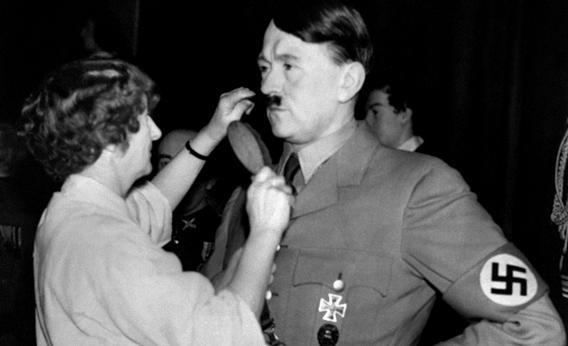J.C. Penney inadvertently sparked controversy by selling a teakettle that critics say looks like Adolf Hitler. The kettle’s handle features an angled black bulge that resembles the Führer’s haircut, and its spout is raised in what looks like a Nazi salute. The most striking feature in the photograph is a black stripe down the middle of the kettle that recalls Hitler’s most famous feature: his tiny mustache. How popular was that style of mustache in Hitler’s day?
Not very. Historians regularly refer to Hitler’s famous mustache as a “toothbrush mustache,” which was a fashionable form of facial hair in the early 20th century, particularly in Northern Europe. The trimmed-down style was a modernist departure from the thick, sweeping whiskers that had been popular in Kaiser Wilhelm II’s Germany. The dashing German soldier and race car driver Hans Koeppen sported the toothbrush mustache, which a 1908 New York Times article referred to as “characteristic of his class.” German Crown Prince Wilhelm wore a toothbrush during the 1910s. Even a young Walt Disney grew a toothbrush mustache in 1925 to make himself look older in business negotiations. As the oft-told narrative goes, the toothbrush mustache lost popularity when it became inextricably linked to the despised Nazi leader. But this historical tale has a flaw: Hitler’s mustache wasn’t a classic toothbrush. His whiskers were bushier and more narrow and, at best, could only be referred to as a “variant of the toothbrush style.” Even at the height of his power, many Germans thought Hitler’s facial hair terribly unfashionable.
Bavarians of Hitler’s era referred to his style of mustache as a Rotzbremse, or “snot brake.” Other nicknames include Fliege (fly), Zweifinger (two-finger), or_Chaplinbart. Prior to Hitler’s rise, the small mustache was primarily associated with Charlie Chaplin, both in the United States and Europe. One company sold Chaplin outfits that relied almost entirely on the mustache to create the resemblance. According to a 1915 issue of Motion Picture Magazine, there was a brief moment of popularity for the Chaplin mustache in America. By most accounts, however, the mustache was never much more than a novelty item or a joke, a fact demonstrated by the style’s other famous wearer: Oliver Hardy.
Some have suggested that Hitler borrowed his grooming style from Charlie Chaplin, but there’s no evidence for the claim. Wherever he got the idea, though, even the Führer knew his mustache wasn’t exactly au courant in Germany. When Ernst “Putzi” Hanfstaengl, one of Hitler’s close friends, urged him to abandon the “ugly” mustache, Hitler responded, “If it is not the fashion now, it will be later because I wear it.”
It didn’t quite work out that way, of course. Today, any arrangement of facial hair even vaguely resembling the Hitler mustache is subject to public ridicule. Michael Jordan was teased endlessly for wearing a narrow mustache in a commercial for Hanes underwear. (The faux pas earned him the nickname “Herr Jordan.”) He eventually reverted to a more traditional mustache. Mockery hasn’t deterred Zimbabwean strongman Robert Mugabe, though. He wears his mustache without shame, and has referred to himself as “the Hitler of our time.”
Got a question about today’s news? Ask the Explainer.
